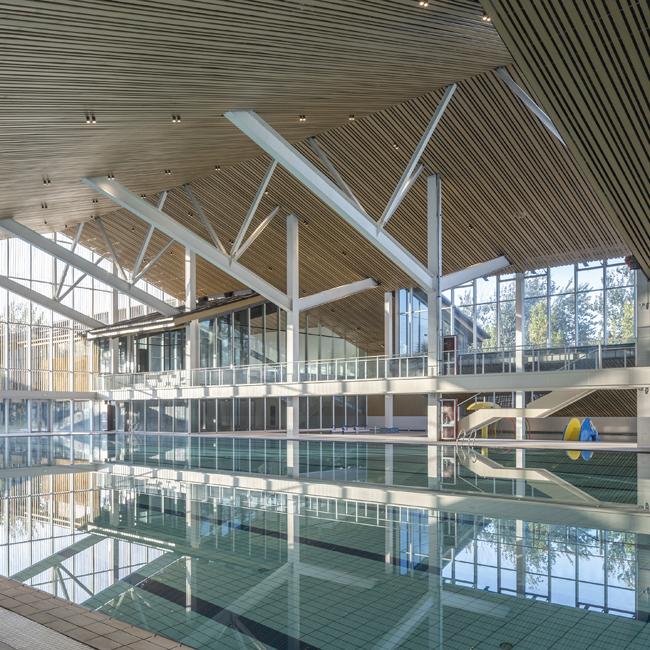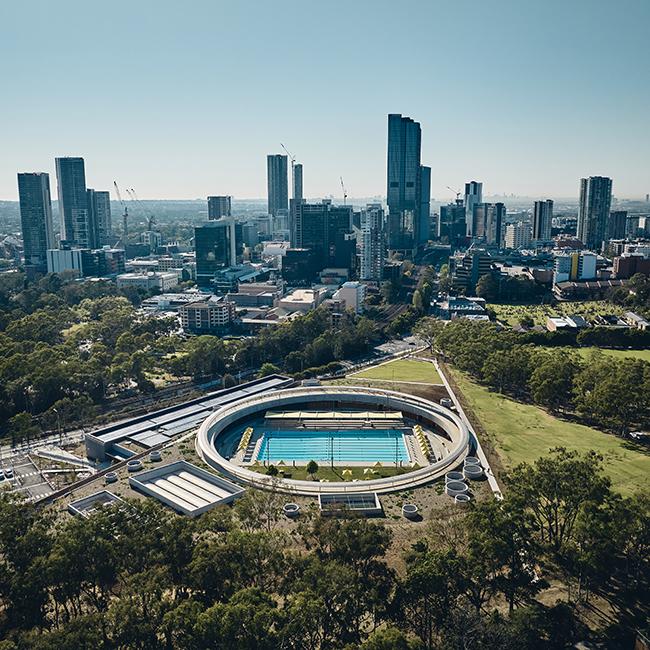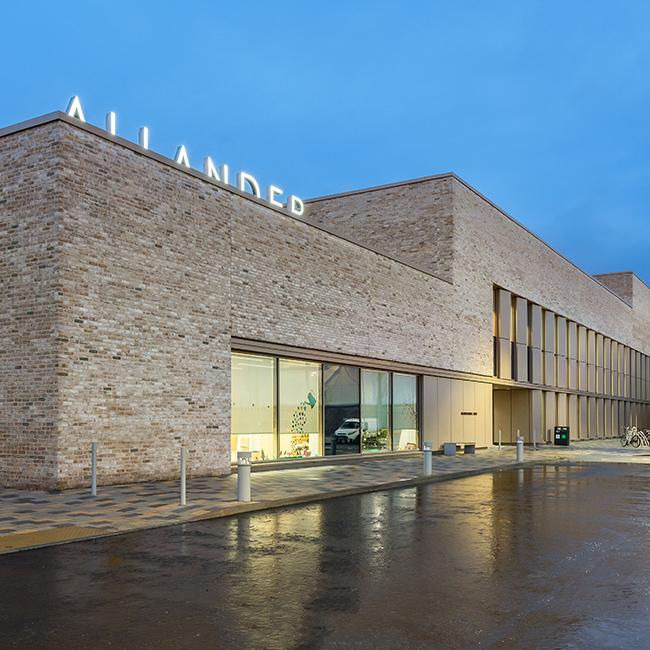Leap in time on the river Alster
published in sb magazine 6/2021
The location looks back on a long tradition: the river bathing facility built in 1927 was initially fed by water from the river Alster. After reinforced concrete pools and mains water were introduced in the 1960s and a new indoor pool was built in 1972, it became possible to run the facility all year round. The new building designed by the architects Czerner Göttsch Architekten in 2019 takes bathers on a journey back in time to the period of the original building, while, thanks to modern building services, the energy requirements of the new pool are significantly lower than those of its predecessor, despite the fact that the water surface area is twice as large.
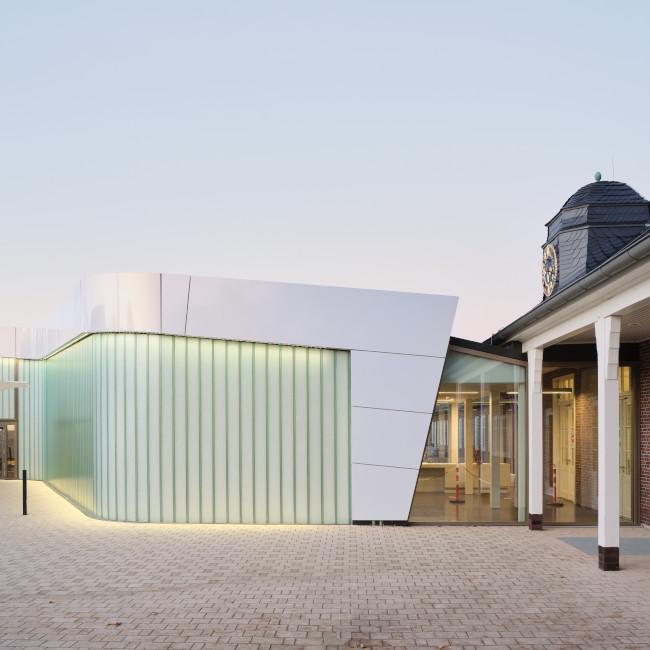
photo: Meike Hansen (archimage)

photo: Meike Hansen (archimage)
In 1927, a river bathing resort was built at the swimming pool’s current location. For this, two natural pools of imposing dimensions were built right by the river Alster. Large pipes connected the pools to the Alster and ensured a controlled exchange of water. Fritz Schumacher, then chief building director of the City of Hamburg, designed the functional buildings in a strict geometrical arrangement, comprising the main building with its formal entrance, offices and lifeguard‘s quarters as well as a changing room building with showers and toilets.
In the 1960s, the baths were redesigned in line with the times, not least for hygienic reasons: The old pools were filled in and replaced with reinforced concrete pools in the typical design of the time. The water supply was switched from the river Alster to mains water. In 1972, the construction of a new indoor pool made it possible to run the facility all year round. Of the buildings of the river baths, only the reception building remained, but it was deprived of its original function, as the facility now had a central entrance via the new indoor pool.
Good to know

photo: Susanne Backhaus (cga)
Location
Hamburg, Germany
Operator
Bäderland Hamburg GmbH
Architects
czerner göttsch architekten
architektur + stadtplanung
DE – 22767 Hamburg
www.czernergoettsch.de
Authors
Architecture: Jürgen Göttsch, Susanne Backhaus (cga)
Technology: Ingo Schütz (Bäderland Hamburg)
Photos
Meike Hansen (archimage)
Susanne Backhaus (cga)
Official Opening
June 2020
Construction Costs
EUR 19 million
New building with extended offering
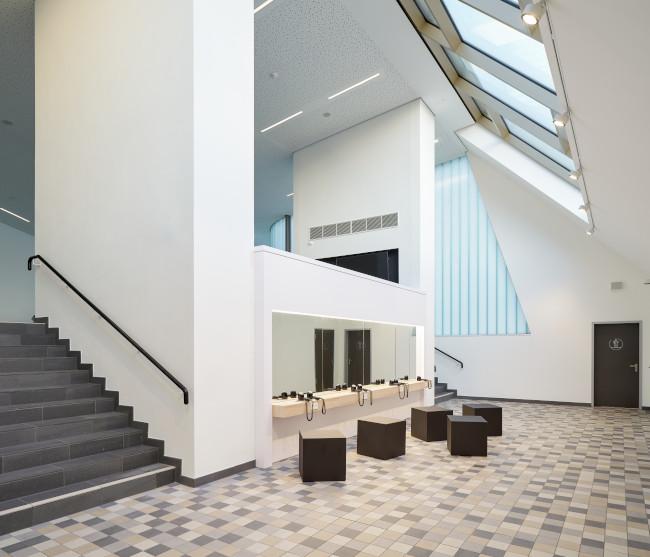
photo: Meike Hansen (archimage)
The client’s decision to restructure the technically outdated and loss-making facility dating from the 1960s pursued a long-term strategy and marked the end of an elaborate process with the overriding goal of securing the future of the location for school and club swimming, families and competitive swimmers. The new building comes with a flexible, extended offering, i.e. a significantly larger water surface area that can be used all year round, swimming courses and special features for children. The newly designed, spacious grounds provide opportunities for relaxation, sport and play.
Modification during ongoing operation

photo: Meike Hansen (archimage)
The existing indoor swimming pool built in the south of the property in 1972 had to remain in operation until the new pool was opened, mainly to maintain a basic service for schools and clubs. The northern third of the site was sold off for housing. As a result, the spatial programme had to be implemented in an elongated, narrow construction slot on a slope behind Fritz Schumacher’s historic entrance building. The pool grounds could only be completed after the commissioning of the new building and demolition of the old pool.
The historic reception building with its brick façade, clock tower and shallow, slate-decked hipped roof serves as the yardstick for the elevation of the overall ensemble. The slope was used to model the building into the topography and to respect the natural surroundings of the Alsterpark, which is supported by the greened roof surfaces. As a result, the changing and sanitary areas in the north are barely visible, and the future residents of the new residential development look out onto an area of greenery from which at night the diffuse light of the skylights glows.
Leap in time from the entrance building

photo: Susanne Backhaus (cga)
Users enter the facility via the preserved entrance building from 1927, which has been refurbished on historical principles and regained its original purpose as an entrance hall after decades of being put to alternative use. From the “Green Hall” with its tiles and clinker brick floor, one experiences a leap in time on entering the bright, dynamically curved foyer, which features a floor of polished mastic asphalt screed, a curved south façade of profiled glass and the organically shaped reception counter made of Corian.
The foyer leading on from the entrance building affords barrier-free access to the lower level. Here, in addition to the functional areas such as changing, sanitary and storage rooms, there is also the bathing hall partitioned by a transparent wall, with three pools arranged in series.
Competitive swimming and play
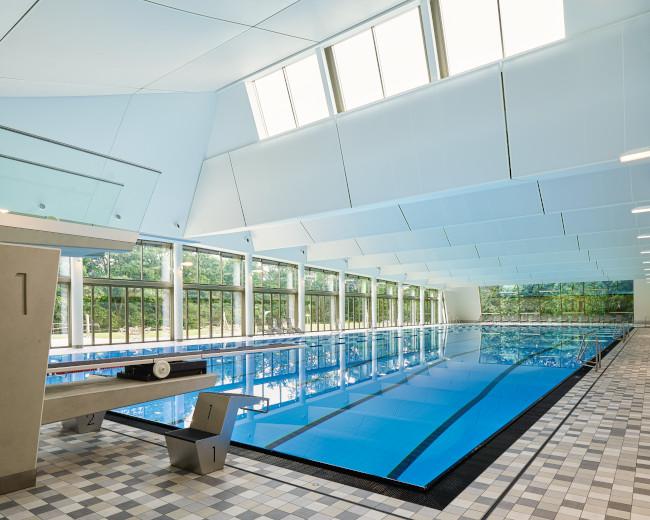
photo: Meike Hansen (archimage)
The offering for bathers has been expanded and flexibly designed. The 50-m-pool with its seven lanes is suitable for competition and can be divided by a movable wall, making it versatile. Equally flexible is the 230 m² teaching pool, whose water depth can be changed by a movable floor and adjusted to the requirements of the course in question. The pools are made of waterproof concrete, and the moving elements (movable wall and floor) are also made of concrete. The competition equipment also includes a 1-metre and a 3-metre diving tower, along with starting blocks.
The offering also extends to an organically shaped paddling pool for children with a water slide and fountains activated at irregular intervals as well as an inviting rest area for parents.
The 90 m long bathing hall is divided into two usage areas by an internal glass wall: the swimmers’ and competition area, and the teaching and children’s area, which is a few degrees warmer. The pool attendant’s room with a view of both parts of the hall is centrally located right at the glass partition. Most of the south and west of the swimming pool is glazed and looks out onto the Alster parkland with its mature trees. Large parts of the glazed south façade can be opened onto the terrace and sunbathing lawn. The flowing transition from the interior to the spacious outdoor grounds gives the facility the character of an outdoor pool.
Spacious grounds
The site, which falls away some six metres to the Alster, has been zoned into areas for sport, rest and play. A bank of seating steps has been built against the retaining wall of the car park and serves as a grandstand for the beach volleyball court. The grounds also include a terrace, sunbathing lawn and the water playground for children with play fountains. A users’ car park, delivery zone and fire service access lane are arranged at street level behind the historic reception building.
Elegance and composure

photo: Meike Hansen (archimage)
The façades are made of white Alucobond panels that shine in a low-key, iridescent shade of gold reflecting the lighting mood, while expressing elegance and composure at the same time and thus conveying a lightness that contrasts pleasantly with the revitalised brick architecture by Fritz Schumacher. The bathing hall’s ceiling structure consists of 1.85 m high wooden trusses, supplemented by an elevated steel framework construction over the diving tower. A light-coloured, folded textile membrane ceiling is fitted beneath the trusses and beams, creating a visually and atmospherically pleasant tension in the interior, while also concealing installed equipment and having a sound-reducing effect on the room acoustics.
Restrained colour scheme in the bathing hall

photo: Meike Hansen (archimage)
In addition to the blue of the pools, the colours of earths and pebbles predominate, recalling the colours of the beach at the seaside. The surfaces and colours of the hall continue without interruption through the showers and changing rooms to the hair-drying stations adjacent to the foyer. In response to the request for a purely pictorial wayfinding system, the architects developed their own series of pictograms for navigation within the building.
The sweeping, brightly designed foyer with its ingenious combination of materials performs numerous functions, serving as a reception for users, as an admission and waiting area for young swimmers and school groups, and as a switchboard for equipment and admission control. A plant level has been installed beneath the entire swimming pool and changing room area.
Sustainable and energy-efficient pool equipment

photo: Susanne Backhaus (cga)
Six ventilation systems with a total flow of roughly 100,000 m³/h have been installed. The systems are all equipped with frequency converters and, where necessary, cross-flow heat exchangers. Heat is generated by two 385 kW condensing boilers and a 142 kWel combined heat and power unit. The pool equipment consists of three systems: competition pool/water playground, teaching pool and paddling pool. During operating hours, the entire water is recirculated via the overflow channel. Outside opening hours, the water level in the pools is lowered slightly and the water is recirculated without the channel on the basis of pool water quality.
Furthermore, a flushing wastewater treatment system conforming to DIN 19643, type 3, has been installed. The treated water is discharged into the receiving water body. All showers are equipped with electronic thermostatic mixers.
The lighting is controlled via a KNX bus system that makes many different lighting scenarios available to suit the time of day and user groups. The entire building services system is equipped with a large number of energy and water meters, which send their meter readings to a Web-based energy monitoring system every 15 minutes. In this system, the actual data are compared with predefined target value windows and if the values fall outside the target range, an alarm is triggered to alert the staff on site to excessive water consumption, for example.
The abundance of technical measures, energy monitoring and, last but not least, the highly efficient insulation of the building structure have significantly reduced the new pool’s energy demand over that of the old pool, despite the fact that the new water surface area is twice the size.
Prefer to have your own copy? Or even better: subscribe to the sb magazine - and you receive all six issues per year
Three questions to Alexandra Czerner and Jürgen Göttsch
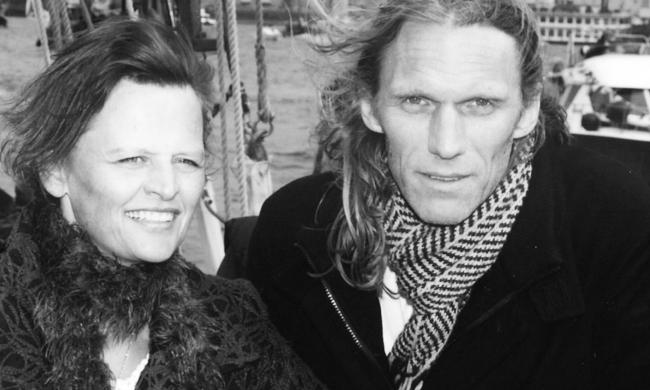
Alexandra Czerner, Jürgen Göttsch (from left to right)
The existing indoor swimming pool dating back to 1972 in the south of the site had to stay in operation until the new pool went into operation. What effect did this constraint have on the process?
Bäderland recognised its responsibility to maintain ongoing swimming opportunities and courses in Ohlsdorf, above all for schools and clubs. Planning had to be subordinated to this overriding principle. In addition, part of the pool grounds had been sold off for housing purposes. The building plot thus shrank to a narrow window extending between the old swimming pool and the housing and behind the historic entrance building into the depths of the site – an ambitious task for designers and builders alike. To make matters worse, the soil and water conditions were problematic, so securing the old pool and the excavation pit in the context of limited accessibility was a real challenge, especially in terms of site logistics. The situation was further aggravated by the fact that safeguarding measures had already been taken to stabilise failing parts of the old pool’s load-bearing structure. Measuring points were installed and monitored to register the slightest movements so that we could react if necessary. Attention also had to be paid to supply lines of the old building. Some underground lines had to be relocated because they obstructed access to the excavation pit.
After completion of the new building and the opening of the pool in June 2019, the demolition of the old pool got underway. Now we had to take care to protect the new building. For example, we built a temporary fire service access road, as the permanent one could only be constructed after demolition of the old pool. Scaffolding was put up to protect the new building from demolition activities, and school classes had to be able to get to their swimming lessons safely. The landscaping of the grounds had to wait until the demolition of the old pool was over, which meant the new pool wasn’t finished until about a year after opening.

photo: Susanne Backhaus (cga)
By building the new pool, the client was pursuing a strategy of reconfiguration. To what extent did the resulting operational strategy affect the design in advance?
Our office was involved in the decision-making processes from the outset and supported the project over a period of 15 years through all stages of public and political debate. The outdoor pool season in Hamburg lasts a maximum of four months. Taking the average of several years, the pools are only put to significant use for a few weeks during this period. In Ohlsdorf, keeping the outdoor pool running would have entailed considerable investment. This is why Bäderland decided to build a new pool, various forms of which had been planned and discussed over the years. Our approach also swayed opinion in that we doubled the water surface that can be used all year round. The pool’s concentration on school and club swimming, families and competitive swimming resulted in the decision to build a competition-standard 50-m-pool. Wellness facilities were omitted as a result. The large sunbathing lawn was retained, and since almost the entire south side of the hall opens onto the lawn, we managed to retain the character of an outdoor pool. Thus, in only a short while, Ohlsdorf family pool has secured its permanent place in Hamburg’s pools strategy.
The façades are clad with white aluminium panels, while the swimming hall is dominated by earthy tones and pebble colours in addition to the blue of the pools. What kind of atmosphere does the restrained colour scheme create?
The choice of materials and colours was an important part of the architectural concept. Although the pool is traditionally classified as a family pool, its commitment to competitive swimming concurs just as well with its designation as a pool for schools and club swimming. In addition, the building is part of the Alsterpark landscape area, so a powerful experience of nature is possible both inside and out. The view through the large window fronts makes it possible to experience the backdrop of the trees and the glinting of the river Alster. To allow this atmosphere to unfold, the architecture and the chosen materials and colours are free of ostentatious effects or surfaces that appear hard and sterile. There are no obtrusive colours and shapes, nor is there eye-catching scenery or attractions. We let the space, the light, the matt surfaces and the muted colours take their effect. Visitors have endorsed our approach by commenting on the pleasant level of brightness and the relaxing atmosphere.
As a contrast to the dignified entrance building from the 1920s, the monochrome façades in a radiant white highlight the new building’s sculptural effect. Depending on the mood created by the light, the trees and clouds are reflected in the aluminium panels, or the sun causes the gently shimmering shade of gold concealed in the material to glow. A modern building devoid of pretensions that, for all its elegance, exudes a pronounced atmosphere of well-being.


